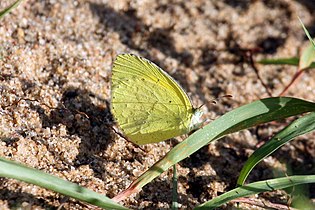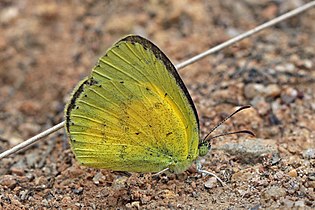
Papilio helenus, the red Helen, is a large swallowtail butterfly found in forests of southern India and parts of southeast Asia.

Dodona durga, the common Punch, is a small but striking butterfly found in the Indomalayan realm that belongs to the Punches and Judies, that is, the family Riodinidae.

Dodona ouida, the mixed Punch, is a small but striking butterfly found in the Indomalayan realm in West China, Himalayas, Northeast India (hills) and Burma that belongs to the Punches and Judies, that is, the family Riodinidae.

Eurema laeta, the spotless grass yellow, is a small butterfly of the family Pieridae, which is found in India, Sri Lanka, China, Indochina, Japan, and onwards to Australia.

Eurema andersonii, the one-spot grass yellow or Anderson's grass yellow, is a small butterfly of the family Pieridae, that is, the yellows and whites, which is found in India and other parts of Asia.

Eurema blanda, the three-spot grass yellow, is a small butterfly of the family Pieridae which is found in Sri Lanka, India and southeast Asia.

Appias lalage, the spot puffin, is a small butterfly of the family Pieridae, that is, the yellows and whites, which is found in India, Indochina and Hainan.

Appias indra, the plain puffin, is a small butterfly of the family Pieridae, that is, the yellows and whites, which is found in south and southeast Asia.

Appias libythea, the striped albatross, is a small butterfly of the family Pieridae, that is, the yellows and whites, which is found in south and southeast Asia.
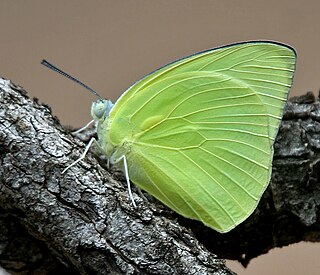
Catopsilia pomona, the common emigrant or lemon emigrant, is a medium-sized pierid butterfly found in Asia, Cambodia and parts of Australia. The species gets its name from its habit of migration. Some early authors considered them as two distinct species Catopsilia crocale and Catopsilia pomona.

Catopsilia pyranthe, the mottled emigrant, is a medium-sized butterfly of the family Pieridae found in south Asia, southeast Asia, and parts of Australia.

Mycalesis subdita, the Tamil bushbrown, is a satyrine butterfly found in south India and Sri Lanka. It is not resolved whether this is a good species or is a subspecies of Mycalesis visala.

Prosotas noreia, the white-tipped lineblue, is a species of lycaenid butterfly found in South Asia and Java.
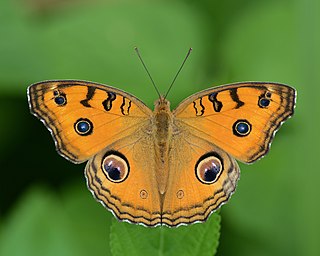
Junonia almana, the peacock pansy, is a species of nymphalid butterfly found in Cambodia and South Asia. It exists in two distinct adult forms, which differ chiefly in the patterns on the underside of the wings; the dry-season form has few markings, while the wet-season form has additional eyespots and lines.It is listed as Least Concern in the IUCN Red List.

Neptis nata, the clear sailer or dirty sailer, is a species of nymphalid butterfly found in south and southeast Asia.
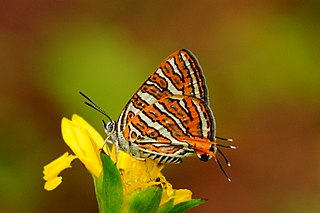
Cigaritis vulcanus, the common silverline, is a species of lycaenid or blue butterfly found in Asia. It was first described by Johan Christian Fabricius in 1775.

Horaga onyx, the common onyx, is a species of lycaenid or blue butterfly found in Asia.

Zeltus is a butterfly genus in the family Lycaenidae, the blues. It is monotypic containing the species Zeltus amasa, the fluffy tit, a small butterfly found in Indomalayan realm. The butterfly is found in India, specially the Western Ghats, Sikkim to Assam. It can also be found in Myanmar, Thailand, West Malaysia, Sumatra, Borneo, Java and the Philippines.
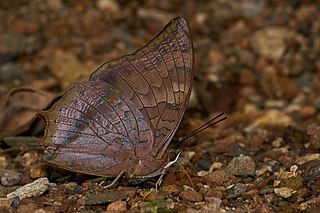
Charaxes psaphon, plain tawny rajah, is a butterfly in the family Nymphalidae. It was described by John Obadiah Westwood in 1847. It is found in the Indomalayan realm.

Heteropsis davisoni, the Palni bushbrown, is a species of satyrine butterfly found in southern India. Some authors consider this as a subspecies of Heteropsis mamerta or Mycalesis malsara or Mycalesis lepcha.





